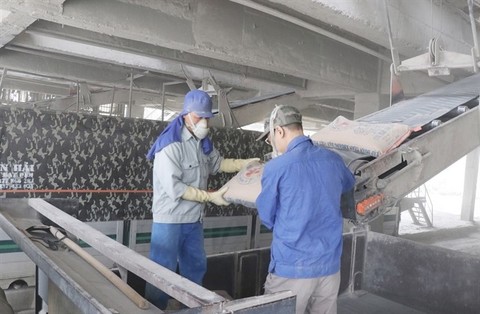
A worker at a steel production line at Thái Nguyên Iron and Steel JSC. VNA/VNS Photo
Despite the approaching official operational roadmap for the Carbon Border Adjustment Mechanism (CBAM), misinformation persists, preventing businesses from fully understanding its implications, which in turn leads to ineffective strategies and resource wastage.
The European Union (EU) introduced the CBAM to address greenhouse gas emissions in specific imported goods entering the EU. In effect since October 1, 2023, the mechanism currently targets six imported commodity groups: cement, electricity, fertilisers, iron and steel, aluminium, and hydrogen.
From January 1, 2026, the CBAM will transition into its full operational phase, applying carbon taxes on regulated goods exported to the EU based on their greenhouse gas emissions during production.
One year after the CBAM’s official rollout, awareness among Vietnamese businesses about the mechanism remains limited.
A survey conducted in January 2023, before the mechanism's transitional phase, revealed that business awareness at the time was relatively low, said Nguyễn Hồng Loan, a project specialist in technical assistance for the CBAM Impact Assessment, at a recent event.
"Except for a few businesses in directly affected sectors that have done thorough research and preparation, the majority of businesses have not responded or made efforts to reduce emissions in their export products to meet European standards," Loan said.
According to Loan many businesses mistakenly believe the CBAM will only affect them if their exported goods exceed Europe’s emission thresholds. In reality, the mechanism covers emissions across the entire product lifecycle.
Additionally, companies in industries such as rice and plastics, which are not yet directly affected, are seeking advice on how to prepare for the CBAM.
Some businesses have overreacted, expressing concerns about potentially facing carbon prices equivalent to those in Europe once the CBAM is fully implemented.
"Regarding new mechanisms like the CBAM, businesses may face challenges in understanding the information and preparing appropriately," Loan said.
Without submitting greenhouse gas emission reports for their products, businesses will be unable to export to Europe. Without official guidance from relevant authorities, companies will need to invest significant time and resources into preparing.
This could lead to inefficiencies, ineffective responses to the mechanism's requirements, and even unnecessary purchases of carbon credits, according to the specialist.
Meanwhile, European guidelines on carbon pricing mechanisms and credit offsets remain ambiguous and lack widespread recognition. This uncertainty may result in unfocused preparations that don’t utilise formal channels, potentially leading to financial losses.

Cement production at VVMI La Hiên Cement JSC. Cement is one of the sectors affected by the CBAM. VNA/VNS Photo
Need for an information gateway
Đinh Quốc Thái, general secretary of the Việt Nam Steel National Association (VSA), said that the steel industry required reliable and comprehensive information to effectively adapt to the mechanism amid a flood of conflicting data.
In 2023, Việt Nam produced around 20 million tonnes of steel, exporting approximately US$8.9 billion, with 27 per cent going to the EU, making it one of the top three markets for Vietnamese steel.
The World Steel Association ranked Việt Nam thirteenth globally in steel production, leading both Asia and Southeast Asia in production and consumption.
"This is a significant market. With mechanisms that affect production volume and export business, it is essential for the industry to study and consider these factors carefully," Thái said.
The VSA representative urged government bodies, particularly the Ministry of Industry and Trade (MoIT), to swiftly refine the draft of the Steel Industry Development Strategy for Việt Nam through 2030, aligning it with the 2050 vision for sustainable and green growth.
To comply with new demands and standards, businesses also need initial support in consultancy, technology expertise, and financial backing from green financing institutions.
Expert Loan advised businesses to closely monitor the EU’s CBAM implementation roadmap as tailoring responses to align with financial and resource capabilities is crucial for effective adaptation.
Hoàng Văn Tâm, a representative of the Department of Energy Efficiency and Sustainable Development under the MoIT, acknowledged that while Việt Nam has its own carbon emission reduction policies, CBAM regulations differ.
Collaboration with the EU is necessary to standardise methods for businesses, according to Tâm. He noted that as awareness grows, companies were investing more in green production transitions.
To help businesses comply with evolving regulations in markets like the EU and the UK, the MoIT planned to create a comprehensive handbook offering guidance on understanding and applying regulations.
Ngô Chung Khanh, deputy head of the Multilateral Trade Policy Department under the MoIT, said that on August 24, the Government tasked the ministry with spearheading efforts to address the mechanism in collaboration with other relevant ministries and agencies.
To facilitate this initiative, the MoIT put forward various proposals, including establishing carbon pricing regulations and raising awareness to ensure businesses understand the mechanism accurately.
The ministry also recommended enhancing direct training programmes to improve businesses’ readiness and compliance with the mechanism.
A centralised Vietnamese-language CBAM information hub was strongly recommended. This platform would provide detailed explanations and precise guidance on the mechanism's intricacies, helping Vietnamese enterprises optimise their strategies and navigate the mechanism's requirements effectively. VNS